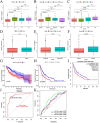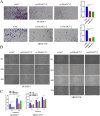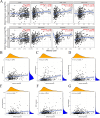Increased expression of DNAJC7 promotes the progression of hepatocellular carcinoma by influencing the cell cycle and immune microenvironment
- PMID: 40312488
- PMCID: PMC12045834
- DOI: 10.1007/s00432-025-06202-0
Increased expression of DNAJC7 promotes the progression of hepatocellular carcinoma by influencing the cell cycle and immune microenvironment
Abstract
Background: Hepatocellular carcinoma (HCC) is the leading cause of cancer-related mortality worldwide owing to the lack of effective and early diagnostic tools and therapeutic approaches. DNAJC7, a member of the DnaJ heat shock family, is crucial in protein folding and stability; however, its specific functions and mechanisms in HCC remain unclear.
Objective: This study aimed to explore the role of DNAJC7 in HCC progression and evaluate its potential clinical significance as a prognostic marker.
Methods: Public databases (TCGA, ICGC, GEO, and TIMER) were used to assess DNAJC7 expression, correlations with clinical parameters, and related signaling pathways. Proliferation, migration, invasion, and cell cycle assays were performed to evaluate the function of DNAJC7 in HCC. Immune infiltration and associations with checkpoint proteins were analyzed using TIMER, and a Gene Set Enrichment Analysis (GSEA) was used to explore enriched pathways.
Results: DNAJC7 expression was higher in HCC tissues than in adjacent normal tissues and was associated with advanced malignancy and poor prognosis, including a lower overall survival, progression-free survival, and disease-free survival. DNAJC7 knockdown resulted in reduced malignant behavior of HCC cells, leading to S-phase cell cycle arrest. Increased DNAJC7 expression was associated with immune cell infiltration and the presence of immunological checkpoint molecules, including CTLA4 and PD-1. GSEA highlighted the activation of key pathways, including WNT signaling and cell cycle regulation.
Conclusion: DNAJC7 regulates tumor cell proliferation, migration, invasion, and immune evasion by acting as an oncogene in HCC. It can serve as a diagnostic and prognostic biomarker and potential treatment target for HCC.
Keywords: DNAJC7; Hepatocellular carcinoma; Prognosis; Signaling pathway.
© 2025. The Author(s).
Conflict of interest statement
Declarations. Ethical approval: All clinical data in this study were sourced from public databases and do not require an ethical statement. Competing interests: The authors declare no competing interests.
Figures








Similar articles
-
High expression of SMPD4 promotes liver cancer and is associated with poor prognosis.BMC Res Notes. 2025 Apr 10;18(1):159. doi: 10.1186/s13104-025-07212-4. BMC Res Notes. 2025. PMID: 40211349 Free PMC article.
-
[CCDC97 influences the immune microenvironment and biological functions in HCC].Xi Bao Yu Fen Zi Mian Yi Xue Za Zhi. 2025 Jan;41(1):23-30. Xi Bao Yu Fen Zi Mian Yi Xue Za Zhi. 2025. PMID: 39799421 Chinese.
-
TMEM115 as an Oncogenic and Immunological Biomarker in Hepatocellular Carcinoma.Liver Int. 2025 Apr;45(4):e70048. doi: 10.1111/liv.70048. Liver Int. 2025. PMID: 40052693
-
Transcriptional analysis of the expression, prognostic value and immune infiltration activities of the COMMD protein family in hepatocellular carcinoma.BMC Cancer. 2021 Sep 7;21(1):1001. doi: 10.1186/s12885-021-08699-3. BMC Cancer. 2021. PMID: 34493238 Free PMC article.
-
Overexpressed GNAZ predicts poor outcome and promotes G0/G1 cell cycle progression in hepatocellular carcinoma.Gene. 2022 Jan 10;807:145964. doi: 10.1016/j.gene.2021.145964. Epub 2021 Sep 14. Gene. 2022. PMID: 34530087
References
-
- Barcena-Varela M, Monga SP, Lujambio A (2024) Precision models in hepatocellular carcinoma. Nat Rev Gastroenterol Hepatol. 10.1038/s41575-024-01024-w - PubMed
-
- Bray F, Laversanne M, Sung H, Ferlay J, Siegel RL, Soerjomataram I, Jemal A (2024) Global cancer statistics 2022: GLOBOCAN estimates of incidence and mortality worldwide for 36 cancers in 185 countries. CA Cancer J Clin 74:229–263. 10.3322/caac.21834 - PubMed
-
- Chen L, Zhang C, Xue R, Liu M, Bai J, Bao J, Wang Y, Jiang N, Li Z, Wang W et al (2024) Deep whole-genome analysis of 494 hepatocellular carcinomas. Nature 627:586–593. 10.1038/s41586-024-07054-3 - PubMed
MeSH terms
Substances
Grants and funding
LinkOut - more resources
Full Text Sources
Medical

